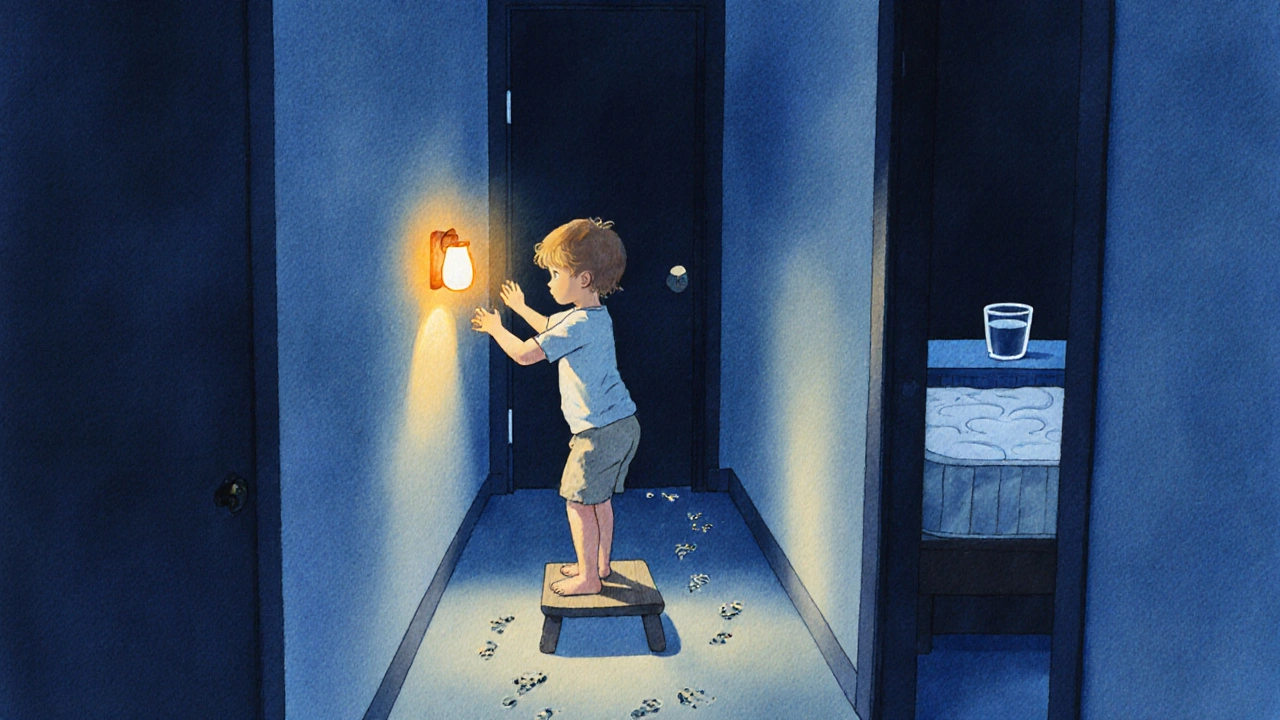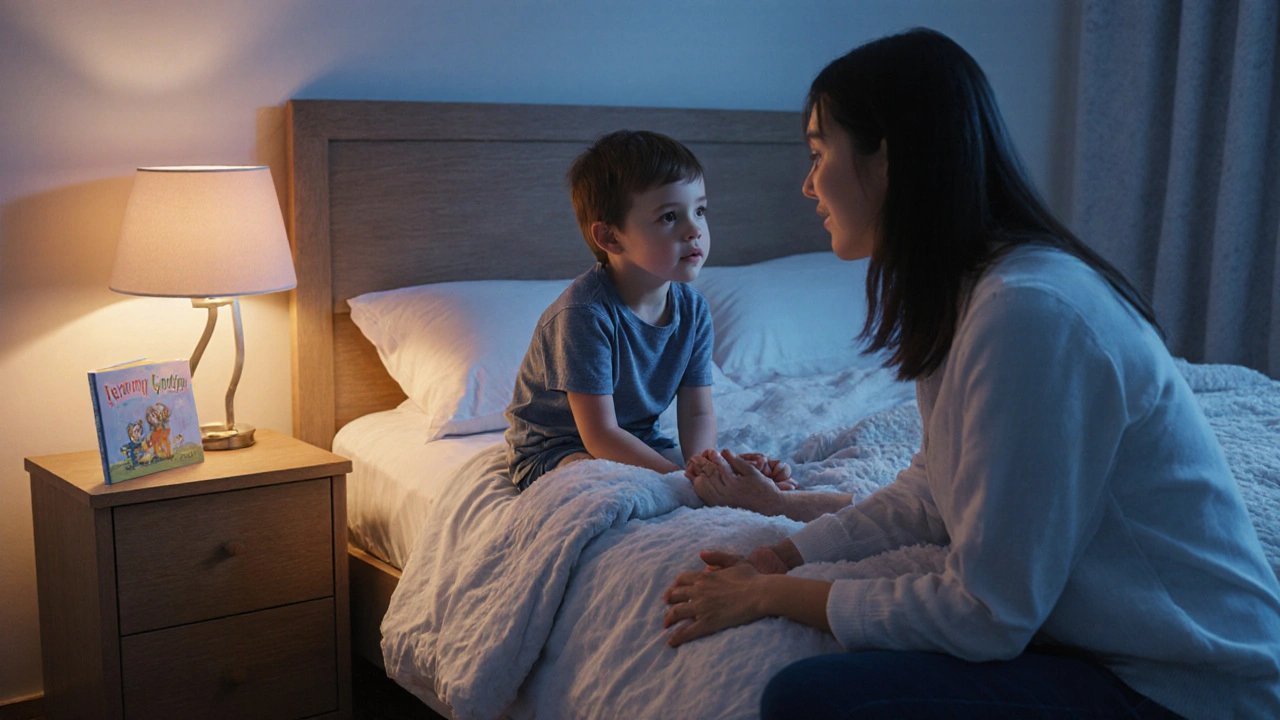Bedwetting Assessment Tool
How to Use This Tool
Answer 4 simple questions to assess your child's situation. This tool helps determine if you should consult a pediatrician or if the pattern is typical for development.
When a child keeps wetting the bed, the first reaction is often panic or frustration. But bed-wetting is a normal part of many kids’ development, and handling it with empathy makes the difference between shame and confidence.
Bed-wetting is a common form of nighttime urinary incontinence in children, also called enuresis. It affects roughly 5‑10% of 5‑year‑olds and can linger into the teen years. Understanding why it happens, how to talk about it, and what practical steps help, lets parents turn a stressful night into a learning moment.
Key Takeaways
- Bed-wetting is usually physiological, not a behavioural problem.
- Talk to your child with calm, non‑judgmental language.
- Simple routine tweaks-fluid timing, bathroom access, protective bedding-reduce accidents.
- Watch for red flags that need a medical evaluation.
- Emotional support is as vital as practical strategies.
Why Bed‑Wetting Happens: The Basics
Children’s bladder capacity, hormone levels, and sleep cycles are still maturing. Three main physiological factors show up most often:
- Enuresis - the medical term for repeated nighttime wetting.
- Low production of antidiuretic hormone (ADH) at night, which normally reduces urine output.
- A bladder that can’t hold a full night’s worth of urine.
These are normal developmental steps; most kids outgrow them without treatment. However, stress, deep sleep patterns, or a small functional bladder can delay that timeline.
How to Talk About It Without Shaming
The first conversation sets the tone. Use clear, age‑appropriate language and keep your voice steady. Here’s a short script you can adapt:
"I noticed the sheet is wet again. That’s okay-lots of kids have this happen. Let’s work together to keep it dry. How do you feel about it?"
Notice three things in that script:
- It normalises the issue (“lots of kids”).
- It invites the child’s feelings, building emotional safety.
- It frames the problem as a shared task, not a failure.
When children feel respected, they’re more likely to cooperate with any changes you introduce.

Assessing the Situation: Medical vs. Behavioural Causes
Most cases are physiological, but a small percentage stem from underlying health concerns. Use the checklist below to decide if a professional opinion is needed.
| Indicator | Medical Signals | Behavioural Signals |
|---|---|---|
| Frequency after age 7 | Persistent daily wetting | Improves with routine changes |
| Daytime urinary symptoms | Urgency, pain, or infection | None |
| Family history | Strong hereditary link | Less relevant |
| Emotional stressors | Usually secondary | Recent school or family changes |
If any medical signals appear-especially pain, blood, or daytime urgency-book a Medical evaluation with a pediatrician. They may order a urine test or check for sleep‑related breathing issues.
Practical Strategies Parents Can Implement Tonight
Even if the cause is purely physiological, a handful of everyday tweaks can cut accidents dramatically.
1. Manage Fluid Intake
Limit drinks after dinner to a reasonable amount (about 4‑6oz). Offer a final bathroom trip right before bed. Fluid intake doesn’t need to be cut entirely-just paced.
2. Optimize the Nighttime Routine
Build a calm wind‑down: dim lights, a short story, and a bathroom visit. Consistency signals the body it’s time to wake up for a pee if needed.
3. Make the Bathroom Easy to Reach
Nightlights in the hallway and a clear path to the toilet reduce the “sleep‑deep” barrier. A small step stool or a toilet seat adapter helps younger kids feel secure.
4. Use Protective Bedding
Water‑proof mattress protectors and absorbent underwear keep the bed dry and protect the child’s self‑esteem. Let your child pick a fun design-they’ll feel more in control.
5. Encourage a “Dry‑Night” Reward System
Simple stickers or a weekly “dry‑night” chart works better than large monetary rewards. Praise effort, not just outcomes.
6. Consider Behavioral Therapy if Needed
When patterns persist, a trained Behavioral therapist can teach bladder‑training exercises and coping skills. This approach is gentle and reinforces confidence.
Supporting Your Child’s Emotional Well‑Being
Beyond the practical steps, emotional support is crucial. Kids can internalise shame and avoid bedtime, which worsens the problem. Here’s how to keep the emotional climate positive:
- Validate feelings. “I see you’re upset; that’s okay.”
- Avoid blame. No “You should have tried harder.”
- Normalize the experience. Share age‑appropriate stories of other kids who overcame it.
- Encourage open dialogue. Check in weekly, not just after accidents.
When children sense unconditional support, they’re more likely to wake up if they need to go, reducing nightly incidents.

When to Seek Professional Help
Most parents can manage bedtime wetting at home, but certain signs demand expert input:
- Wetting continues past age 10 without improvement.
- Daytime urinary problems appear.
- Kid reports pain, urgency, or anxiety around bathroom use. \n
- Family history of kidney or bladder issues.
A pediatric urologist or a child psychologist can run specialized tests and suggest targeted interventions, such as medication to boost ADH or cognitive‑behavioral techniques.
Putting It All Together: A Sample Night‑Time Plan
Below is a simple, compassionate plan you can copy onto a fridge note.
- 6:30pm - Light dinner, limit sugary drinks.
- 7:30pm - Play a calm game, then start bedtime routine.
- 8:00pm - Bathroom visit, nightlight on, mattress protector ready.
- 8:15pm - Storytime, soothing music, then lights out.
- During night - Trust the child’s instinct; if they wake, praise the effort.
- Morning - Review the sheet together, celebrate any dry night, no scolding.
Consistency, kindness, and a few practical tweaks often turn a worrying pattern into a short‑term phase.
Frequently Asked Questions
How old is it normal for a child to still wet the bed?
Most children outgrow bed‑wetting by age 5‑6, but occasional accidents up to age 10 are still within the normal range, especially if no daytime symptoms appear.
Should I wake my child up to use the bathroom?
Initially, a scheduled wake‑up can help train the bladder, but over‑time the goal is for the child to wake naturally. Keep the wake‑up gentle and praise the effort.
Can medications help?
In some cases, doctors prescribe desmopressin to boost nighttime ADH levels. It works for many children but is usually a short‑term aid combined with behavioural strategies.
What if my teenager is embarrassed about the problem?
Teenagers need privacy and reassurance. Offer a discreet protective sheet, reassure them that it’s medical, and suggest a brief meeting with a health professional who can rule out any underlying issue.
Are there any home remedies that work?
Consistent bedtime routines, limiting fluids before sleep, and using a well‑lit path to the bathroom are the most effective low‑cost solutions. Herbal teas like chamomile can promote relaxation but should not replace medical advice.


Ian McKay
October 12, 2025 AT 06:33Your article concisely outlines compassionate strategies for managing pediatric enuresis.
Deborah Messick
October 12, 2025 AT 10:43While the intent is commendable, the exposition would benefit from a more rigorous citation of pediatric urology literature. Moreover, the tone occasionally lapses into anecdotal recommendation.
Jolanda Julyan
October 12, 2025 AT 14:53I truly appreciate the emphasis on empathy when addressing a child’s nocturnal accidents. It is vital that parents avoid shame and instead foster a supportive environment. The suggestion to use a wet‑night alarm aligns well with behavioral conditioning principles. Additionally, tracking fluid intake during the day can reveal patterns that might be modifiable. Introducing a bedtime routine that includes a bathroom visit is a simple yet effective step. It is also helpful to reassure the child that many peers experience similar phases. When stressors are present, acknowledging them openly can reduce anxiety‑related wetting. Finally, consulting a pediatrician is advisable if the frequency exceeds the typical developmental window.
Kevin Huston
October 12, 2025 AT 19:03Let’s be real, this “compassionate” spiel is just a soft‑sell for the latest pricey alarm gadgets that line corporate pockets.
Amanda Hamlet
October 12, 2025 AT 23:13U can try sumahng like a dry potty monitar, its eazy and cheap.
Nolan Jones
October 13, 2025 AT 03:23From a pediatric nurse perspective, start with a simple bladder diary for a week; it often reveals hidden patterns and guides next steps.
Jada Singleton
October 13, 2025 AT 07:33Honestly, most parents over‑react and turn a normal developmental stage into a crisis.
Emily Rossiter
October 13, 2025 AT 11:43Great reminders-keep calm, celebrate dry nights, and involve the child in solution‑finding.
Renee van Baar
October 13, 2025 AT 15:53Putting a waterproof mattress cover on the bed is a practical step that reduces laundry load and protects the mattress while the child works on bladder control.
Mithun Paul
October 13, 2025 AT 20:03In light of recent epidemiological data, the claim that stressors singularly precipitate enuresis seems overly simplistic; multifactorial etiologies must be acknowledged.
Sandy Martin
October 14, 2025 AT 00:13I’ve seen families thrive when they focus on positive reinforcement rather than punishment; it really changes the child’s self‑esteem.
Steve Smilie
October 14, 2025 AT 04:23The prose drifts into a saccharine haze, yet the core advice-regular voiding schedules and supportive dialogue-remains sound.
Josie McManus
October 14, 2025 AT 08:33When a child shows daytime urgency, it’s a signal that a deeper urological assessment might be warranted.
Heather Kennedy
October 14, 2025 AT 12:43From a lexicon standpoint, the term “compassionate” aligns with patient‑centered care models; integrating it into nocturnal enuresis protocols could enhance adherence.
Janice Rodrigiez
October 14, 2025 AT 16:53Tip: limit caffeine after school hours.
Roger Cardoso
October 14, 2025 AT 21:03One might wonder why the medical community suddenly prioritizes “compassion” after decades of purely physiological focus-perhaps a subtle shift in funding agendas?
barry conpoes
October 15, 2025 AT 01:13Let’s cut the fluff-if you want results, enforce a consistent bedtime routine and back it up with data‑driven monitoring.
Kristen Holcomb
October 15, 2025 AT 05:23Exploring the intersection of family dynamics and nocturnal enuresis can uncover hidden stressors that traditional checklists overlook.
justin davis
October 15, 2025 AT 09:33Wow-another “guide” that tells you to stare at the night‑lamp and hope for the best!!! Truly groundbreaking.
David Lance Saxon Jr.
October 15, 2025 AT 13:43In contemplating the ontological underpinnings of pediatric nocturnal enuresis, one must first acknowledge the embodied phenomenology of the child’s bladder as a dynamic organ in perpetual negotiation with neurodevelopmental maturation and environmental contingencies. The neurophysiological circuitry governing antidiuretic hormone secretion, sphincter control, and cortical inhibition operates on a timeline that is neither linear nor universally synchronized across individuals, thereby necessitating a differentiated therapeutic schema. Empirical investigations have demonstrated that hormonal fluxes during pre‑pubertal years can precipitate transient dysregulation of nocturnal urine production, a fact often obfuscated by oversimplified clinical heuristics. Moreover, sociocultural constructs surrounding shame and autonomy exert a profound psychosomatic influence, whereby anxiety potentiates sympathetic arousal and, paradoxically, diminishes bladder capacity. The integration of a wet‑night alarm serves not merely as a mechanical trigger but as an operant conditioning stimulus, reinforcing timely voiding behaviors through a feedback loop. However, the efficacy of such devices is contingent upon consistent parental implementation and the child's cognitive receptivity to aversive cues without fostering deleterious stress responses. Parallel to device‑based interventions, dietary modulation-particularly the attenuation of nocturnal fluid intake and the avoidance of diuretic agents such as caffeine-constitutes a foundational pillar of holistic management. It is imperative to contextualize these recommendations within a framework that respects the child's developmental agency, avoiding paternalistic admonishments that could undermine self‑esteem. A multidisciplinary approach, enlisting pediatric urologists, psychologists, and primary care providers, facilitates a comprehensive assessment that discerns primary nocturnal enuresis from secondary etiologies linked to urinary tract infections, constipation, or neurologic disorders. Ultimately, the clinician’s role is to orchestrate a collaborative plan that harmonizes empirical evidence with compassionate communication, thereby empowering families to navigate this transitional phase with resilience and informed optimism.